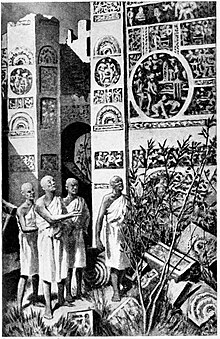Fa Xian
| Fǎxiǎn | |
|---|---|

Faxian at the ruins of Ashoka's palace
|
|
| Religion | Buddhism |
| Monastic name | Fǎxiǎn |
| Personal | |
| Born | 337 Pingyang Wuyang 平陽武陽), in modern Linfeng City, Shanxi |
| Died | ca. 422 (aged 85) |
| Religious career | |
| Works | Foguoji (A Record of Buddhistic Kingdoms) |
| Faxian | |||||||||||||||||||||||||
| Chinese name | |||||||||||||||||||||||||
|---|---|---|---|---|---|---|---|---|---|---|---|---|---|---|---|---|---|---|---|---|---|---|---|---|---|
| Traditional Chinese | 法顯 | ||||||||||||||||||||||||
| Simplified Chinese | 法显 | ||||||||||||||||||||||||
|
|||||||||||||||||||||||||
| Japanese name | |||||||||||||||||||||||||
| Kanji | 法顕 | ||||||||||||||||||||||||
| Kana | ほっけん | ||||||||||||||||||||||||
|
|||||||||||||||||||||||||
| Transcriptions | |
|---|---|
| Standard Mandarin | |
| Hanyu Pinyin | Fǎxiǎn |
| Wade–Giles | Fa3-hsien3 |
| Hakka | |
| Romanization | Fap5-hien3 |
| Yue: Cantonese | |
| Yale Romanization | Fat3-hin2 |
| Southern Min | |
| Hokkien POJ | Huat-hién |
| Middle Chinese | |
| Middle Chinese | Pjop-xén |
| Transcriptions | |
|---|---|
| Romanization | Hokken |
Faxian (337 – c. 422) was a Chinese Buddhist monk who travelled by foot from China to India, visiting many sacred Buddhist sites in what are now Xinjiang, Pakistan, India, Nepal, Bangladesh and Sri Lanka between 399-412 to acquire Buddhist texts. His journey is described in his important travelogue, A Record of Buddhist Kingdoms, Being an Account by the Chinese Monk Fa-Xian of his Travels in India and Ceylon in Search of the Buddhist Books of Discipline. Antiquated transliterations of his name include Fa-Hien and Fa-hsien.
Faxian visited India in the early fifth century. He is said to have walked all the way from China across icy desert and rugged mountain passes. He entered India from the northwest and reached Pataliputra. He took back with him Buddhist texts and images sacred to Buddhism.
Faxian's visit to India occurred during the reign of Chandragupta II. He is also renowned for his pilgrimage to Lumbini, the birthplace of Gautama Buddha (modern Nepal). Faxian claimed that demons and dragons were the original inhabitants of Sri Lanka.
On Faxian's way back to China, after a two-year stay in Ceylon, a violent storm drove his ship onto an island, probably Java. After five months there, Faxian took another ship for southern China; but, again, it was blown off course and he ended up landing at Mount Lao in what is now Shandong in northern China, 30 kilometres (19 mi) east of the city of Qingdao. He spent the rest of his life translating and editing the scriptures he had collected.
Faxian wrote a book on his travels, filled with accounts of early Buddhism, and the geography and history of numerous countries along the Silk Roads as they were, at the turn of the 5th century CE.
...
Wikipedia
